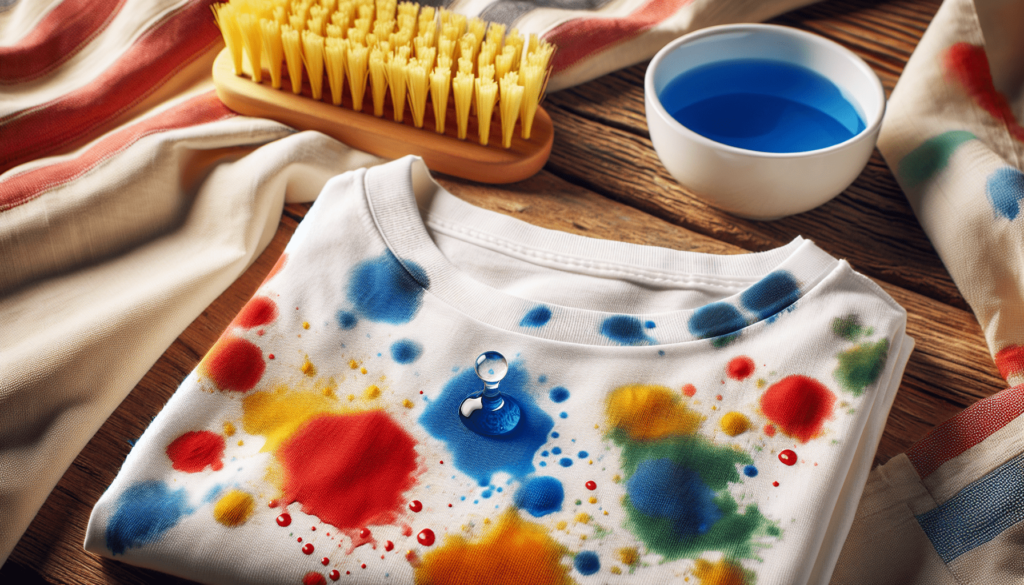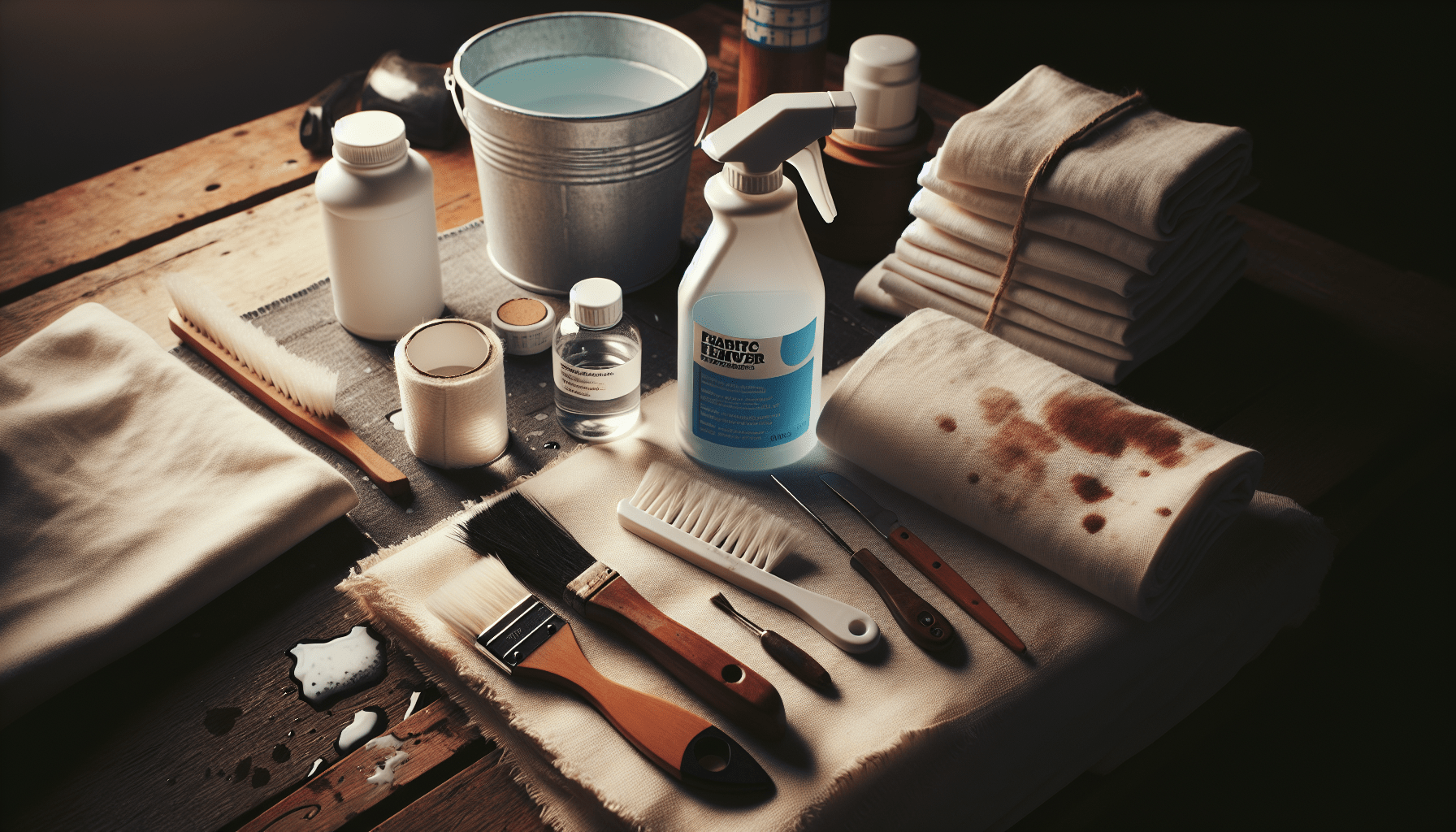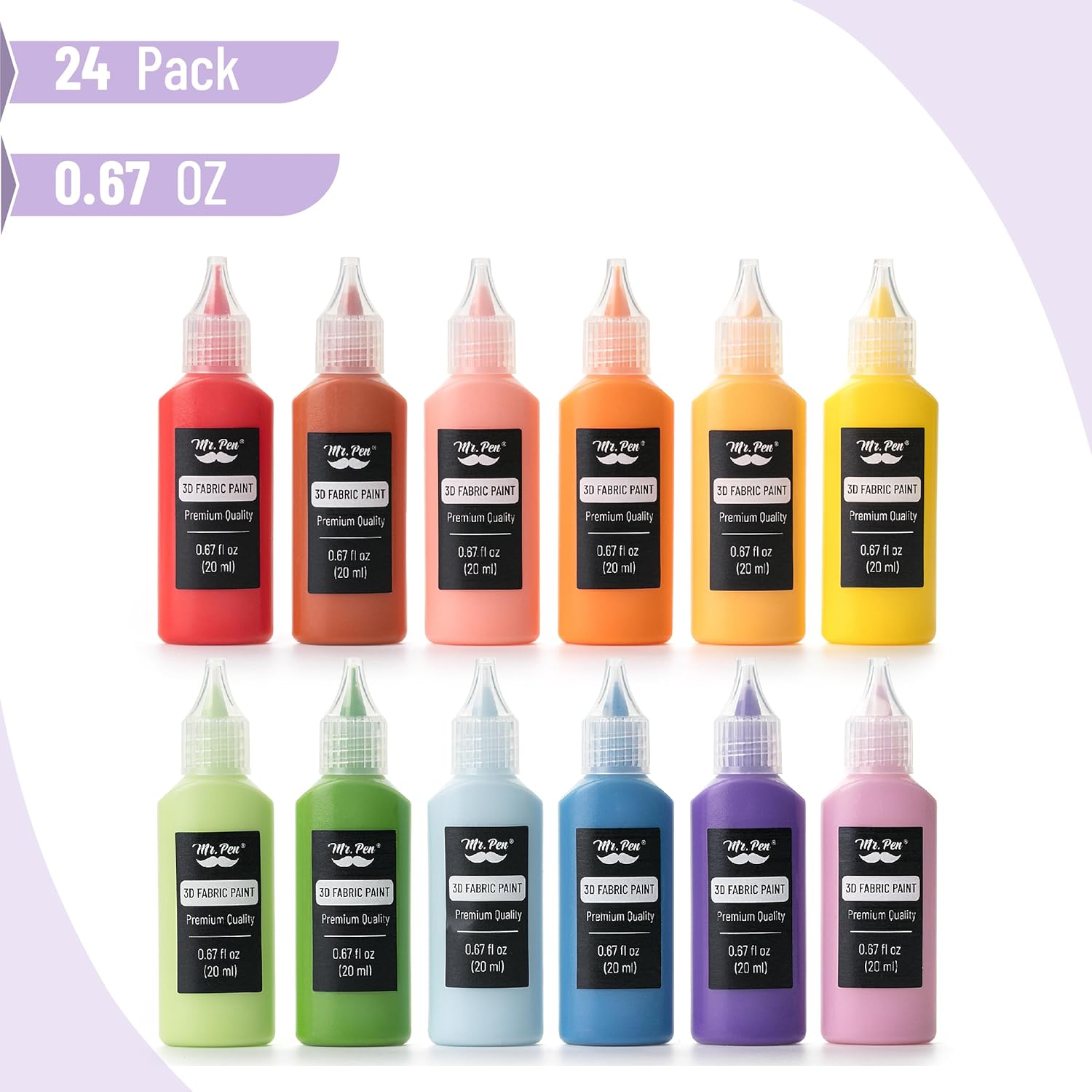Fabric paint can add vibrant colors and unique designs to your clothing, but what happens when an accidental spill or unintentional stroke leaves an unwanted mark? Removing fabric paint from clothes may seem like a daunting task, but with the right methods and a little patience, it can be easily accomplished. In this article, we will explore effective techniques to help you restore your favorite garments and prevent any fashion faux pas. Whether you are dealing with acrylic or water-based fabric paint, we have got you covered. So, let’s get started on the journey to saving your clothes from the clutches of stubborn stains.
Pre-Treatment Methods

Scraping off the Excess Paint
When dealing with fabric paint stains, it’s important to first remove any excess paint from the surface of the fabric. To do this, gently scrape off as much paint as possible using a spoon or a blunt knife. Be careful not to rub or spread the paint further into the fabric.
Blotting with Absorbent Materials
After scraping off the excess paint, you can blot the remaining stain with absorbent materials such as paper towels or clean white cloths. Place the absorbent material underneath the stained area and gently dab the stain from the top using another clean cloth. This helps to absorb any paint that has already soaked into the fabric and prevents it from spreading.
Water-Based Fabric Paint
Water-based fabric paints are generally easier to remove compared to other types of fabric paints. Here are some methods you can use to effectively remove water-based fabric paint stains:
Soaking in Warm Water
Start by soaking the stained garment in warm water. This can help to loosen the paint and make it easier to remove. Let the garment soak for about 20-30 minutes, then proceed to the next step.
Using Dish Soap or Laundry Detergent
After soaking, apply a small amount of dish soap or laundry detergent directly to the stained area. Gently rub the fabric together to create a lather. This will help to break down the paint particles and lift the stain from the fabric.
Applying Rubbing Alcohol
If the stain persists, you can try applying rubbing alcohol to the affected area. Moisten a clean cloth with rubbing alcohol and gently dab the stain, working from the outside towards the center. This should help to dissolve the paint and remove the stain.
Using Vinegar Solution
Another effective method is using a vinegar solution. Mix equal parts of white vinegar and water in a bowl. Apply the solution directly to the stain and let it sit for a few minutes. Then, gently blot the stain with a clean cloth. Vinegar helps to break down the paint and loosen its grip on the fabric.
Pre-Treating with Stain Remover
If the stain still persists, you can pre-treat the area with a fabric stain remover. Follow the instructions on the product label and apply the stain remover directly to the affected area. Let it sit for a few minutes before rinsing the garment thoroughly. This should help to remove the remaining paint and any residual stain.
Acrylic Fabric Paint
Acrylic fabric paint stains may be a bit more challenging to remove compared to water-based fabric paint stains. However, with the right techniques, you can effectively remove acrylic fabric paint from clothes. Here are some methods you can try:
Scraping and Blotting Method
Just like with water-based fabric paint, start by scraping off any excess paint from the fabric using a spoon or a blunt knife. Once the excess paint is removed, blot the stained area with absorbent materials such as paper towels or clean white cloths.
Applying Rubbing Alcohol
After blotting, moisten a clean cloth with rubbing alcohol and gently dab the stain, working from the outside towards the center. Rubbing alcohol helps to break down and dissolve the acrylic paint particles, making it easier to remove from the fabric.
Using Ammonia Solution
For stubborn acrylic fabric paint stains, you can try using an ammonia solution. Mix one part ammonia with three parts water in a bowl. Moisten a clean cloth with the solution and blot the stained area. Be sure to wear gloves and work in a well-ventilated area when using ammonia.
Pre-Treating with Stain Remover
If the stain persists, pre-treat the area with a fabric stain remover. Follow the instructions on the product label and apply the stain remover directly to the affected area. Let it sit for a few minutes before rinsing the garment thoroughly. The stain remover should help to break down the paint and remove the stain.
Oil-Based Fabric Paint
Removing oil-based fabric paint stains requires a slightly different approach due to the nature of the paint. Here are some methods you can use to effectively remove oil-based fabric paint stains:
Scraping off Excess Paint
Start by scraping off any excess paint from the fabric using a spoon or a blunt knife. Be gentle to avoid spreading the paint further into the fabric.
Using Turpentine or Mineral Spirits
Moisten a clean cloth with turpentine or mineral spirits and gently blot the stained area. These solvents help to dissolve the oil-based paint particles and make it easier to remove.
Applying Rubbing Alcohol
After using turpentine or mineral spirits, dab the stained area with a clean cloth moistened with rubbing alcohol. This will help to further loosen the paint and remove any remaining stain.
Using Ammonia Solution
For stubborn oil-based fabric paint stains, an ammonia solution can be effective. Mix one part ammonia with three parts water in a bowl. Moisten a clean cloth with the solution and blot the stained area. Remember to wear gloves and work in a well-ventilated area when using ammonia.
Pre-Treating with Stain Remover
If the stain persists, pre-treat the area with a fabric stain remover. Follow the instructions on the product label and apply the stain remover directly to the affected area. Let it sit for a few minutes before rinsing the garment thoroughly. The stain remover should help to break down the paint and remove the stain.
Applying Stain Remover
Choosing the right stain remover is crucial when it comes to effectively removing fabric paint stains. Here are some tips to keep in mind when applying stain remover:
Choosing a Suitable Stain Remover
Select a stain remover that is specifically designed to tackle fabric paint stains. Look for products that contain enzymes or solvents that can break down the paint particles effectively. Read the product label to ensure it is safe to use on the fabric.
Testing on an Inconspicuous Area
Before applying the stain remover to the stained area, it’s important to test it on an inconspicuous area of the fabric. Apply a small amount of the stain remover and wait for a few minutes to see if any discoloration or damage occurs. If there are no adverse effects, proceed with treating the stain.
Following Product Instructions
Always follow the instructions provided on the stain remover product label. Different stain removers may have varying application methods and recommended waiting times. Adhering to the instructions will optimize the effectiveness of the stain remover.
Applying and Treating the Stain
Apply the stain remover directly to the stained area and gently work it into the fabric using a clean cloth or a soft-bristled brush. Avoid rubbing vigorously, as this can spread the stain or damage the fabric. Allow the stain remover to sit on the stain for the recommended amount of time.

Rinsing and Laundering
After treating the stain with the stain remover, rinse the garment thoroughly with clean water to remove any residual paint or stain remover. Once rinsed, launder the garment according to the fabric care label instructions. This will help to ensure the complete removal of the paint and stain remover.
Machine Washing and Drying
After pre-treating and removing the fabric paint stain, you may need to wash and dry the garment to fully restore it. Here are some steps to follow when machine washing and drying your clothes:
Checking Fabric Care Label
Always check the fabric care label on the garment to determine the appropriate washing instructions. Different fabrics may require different settings or temperature levels. Follow the instructions provided to avoid any damage to the fabric.
Setting the Wash Cycle
Select a wash cycle that is suitable for the fabric type and the intensity of the stain. Use a gentle or delicate cycle for delicate fabrics, and a regular or heavy-duty cycle for sturdier fabrics. Adjust the water temperature according to the fabric care label instructions.
Applying Stain Remover and Pre-Treatment
If any residual stain remains after pre-treatment, apply a small amount of stain remover directly to the stained area before placing the garment in the washing machine. This will help to further break down the stain during the wash cycle.
Laundering the Garment
Place the garment in the washing machine and add the appropriate amount of laundry detergent. Start the wash cycle and allow the machine to complete the washing process. Once finished, inspect the garment to ensure the stain is completely removed before proceeding to drying.
Drying Methods
Check the fabric care label to determine the recommended drying method. Some garments may be suitable for machine drying, while others may require air drying. If machine drying, select the appropriate heat setting. If air drying, hang the garment in a well-ventilated area until completely dry.
Seeking Professional Assistance
In some cases, fabric paint stains may be too stubborn or the garment may be delicate or valuable, requiring the expertise of professionals. Consider the following options when seeking professional assistance:
Considering Professional Dry Cleaning
If the stained garment is made of delicate fabric or if you’re unsure about the appropriate removal method, seeking professional dry cleaning is a safe option. Dry cleaners have the knowledge and expertise to handle different types of fabric and stains effectively.
Taking the Garment to a Specialist
If there are fabric care specialists or textile experts in your area, consider taking the stained garment to them for professional assistance. These specialists have in-depth knowledge of fabrics and stains and can provide tailored solutions for your specific situation.
Explaining the Situation
When seeking professional assistance, provide the specialist with detailed information about the fabric, the paint type, and any previous removal attempts. This will help them assess the situation accurately and determine the best course of action.
Following Care Instructions
After receiving professional assistance, carefully follow the care instructions provided by the specialist. They may recommend specific cleaning methods or aftercare that will help preserve the fabric and prevent future stains.
Additional Tips and Warnings
Here are some additional tips and warnings to keep in mind when removing fabric paint stains:
Acting promptly
It’s important to tackle fabric paint stains as soon as possible. The longer the paint sits on the fabric, the more challenging it becomes to remove. Act promptly to increase the chances of successful stain removal.
Avoiding heat sources
Avoid exposing the fabric paint stain to heat sources such as hot irons or hairdryers. Heat can cause the paint to set into the fabric, making it more difficult to remove.
Avoiding scrubbing
When removing fabric paint stains, avoid scrubbing vigorously. This can spread the paint or damage the fabric fibers. Instead, opt for gentle blotting and dabbing motions to lift the stain.
Avoiding hot water
Avoid using hot water when treating fabric paint stains, especially for delicate fabrics. Hot water can cause the paint to set into the fabric fibers, making it harder to remove. Use lukewarm or cold water instead.
Testing on a small area first
Before applying any cleaning solutions or stain removers to the fabric, it’s always a good idea to test them on a small, inconspicuous area first. This will help you determine if the solution is safe to use and if any discoloration or damage may occur.
Conclusion
Removing fabric paint stains from clothes can be a challenging process, but with the right techniques and methods, it can be done effectively. Pre-treatment methods such as scraping off excess paint and blotting with absorbent materials should be the first steps. Then, depending on the type of fabric paint, you can use specific removal methods like soaking in warm water, applying rubbing alcohol, using vinegar or ammonia solutions, and pre-treating with stain removers.
It’s crucial to choose a suitable stain remover, test it on an inconspicuous area, and follow the product instructions carefully. After treating the stain, machine washing and drying the garment according to fabric care label instructions will help restore its appearance. If the stain persists or the garment is delicate, seeking professional assistance through dry cleaning or consulting fabric care specialists is recommended.
Remember to act promptly, avoid heat sources, scrubbing, and hot water, and always test solutions on a small area first. By following these guidelines and ensuring proper care for the garment, you can successfully remove fabric paint stains and restore your clothes to their original condition.



